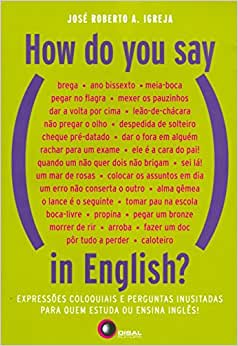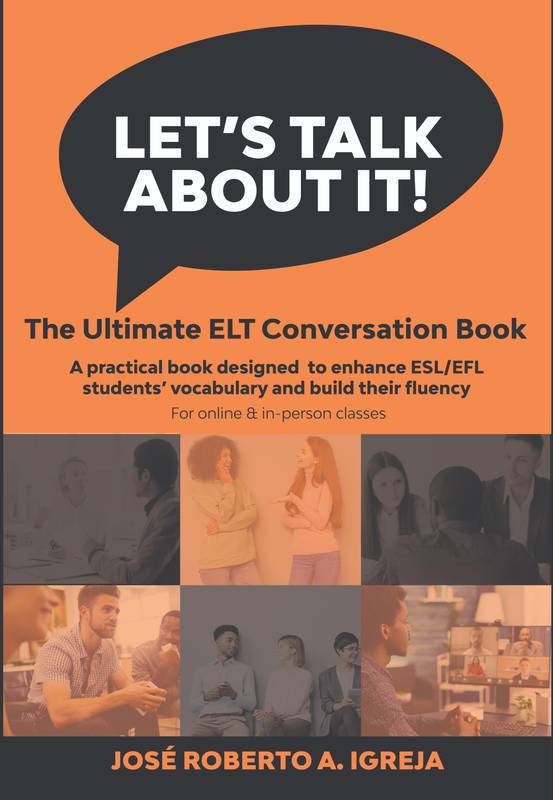by José Roberto A. Igreja
Despite the fact that English teachers have long been used to the question above, it can still cause even the most seasoned ones to be baffled sometimes. As a matter of fact, a host of unexpected brazilian colloquial expressions can be put forward by that question: mexer os pauzinhos; um mar de rosas; fazer um doc; um erro não conserta o outro; pau-pra-toda-obra; cheque pré-datado; leão-de-chácara; entrar no esquema; tomar pau na escola; pegar o jeito; propina; ralé; por debaixo do pano; bambambã; ganhar dinheiro a rodo; fazer vista grossa; rua sem saída; sei lá ! ; the list is endless …
Getting to grips with expressions like the ones above is usually the next step for someone learning English once all grammatical structures and the vocabulary for everyday communication have been mastered. Knowing how to apply them properly in English certainly guarantees a more native-like fluency and therefore, it goes without saying that, our endeavor as resourceful teachers to keep up-to-date with vocabulary and expressions is virtually endless. However, a teacher should be careful not to fall into the trap of trying to live up to some of his students´ unrealistic expectations who believe teachers are walking dictionaries and will always have the answer for every question and doubt on the tip of their tongues. When dealing with languages one should bear in mind that sometimes a certain word or expression may be unique in a language and there may not be a good counterpart for it in another language. Take the portuguese word “saudade” for example!
Two different cultures = two different ways of expressing oneself …
Many students believe, when they first start out to learn the language, that virtually every expression or vocabulary word in Portuguese (be it colloquial or not) can be converted literally into English in the blink of an eye. It should perhaps be important to make students aware of the fact that while many expressions in Portuguese have indeed a literal equivalent in English, “word by word translation” is not always a possibility. Let´s take a look at the chart below where both situations are presented:
Portuguese – English (Literal Equivalents)
Arregaçar as mangas – Roll up one´s sleeves
Sem sombra de dúvida – Without a shadow of a doubt
Matar o tempo – Kill time
Por um fim em – Put an end to
Na ponta da língua – On the tip of one´s tongue
A hora do rush – The rush hour
Saber de cor(ação) – Know by heart
Portuguese – English (Special forms)
Vender que nem água – Sell like hot cakes
Matar-se de trabalhar – Work one´s fingers to the bone
Morrer de rir – Laugh one´s head off
Dormir como uma pedra – Sleep like a log
Dar uma gelada em alguém – Give someone the cold shoulder
Desmancha prazeres – Wet blanket / Killjoy
Dar a volta por cima – Bounce back
Dar a carta branca a alguém – Give someone a free hand
Ele é a cara do pai ! – He´s the spitting image of his father !
Leão-de-chácara – Bouncer
Pegar alguém em flagrante – Catch someone red-handed
Não pregar o olho – Not sleep a wink
Students may find a little strange at first that the corresponding expression to um “mar de rosas” in English is “a bed of roses”, since the word “bed” has nothing to do with “mar” or that the equivalent expression to “o cheque voltou” in English is “the check bounced” (and not “returned” or “came back”!) The point again here is: literal translation does not always work out! It is one of our jobs as English teachers to help our students get over the “word-by-word translation syndrome” and jokingly remind them that the sentence “the cow went to the swamp” does not convey the same meaning as the well-known brazilian expression “a vaca foi para o brejo!”.
Which one? – Making the right choice
Another important aspect that should be considered and that we should often remind our students of is that one single word or expression in Portuguese can correspond to two or more words or expressions in English depending on what we are talking about, and that failing to determine the appropriate context can often lead to mistakes. If a student asks, for example , “How do you say “armário” in English ?”, before answering that question, perhaps it would be better to ask him what kind of “armário” he has in mind. Is he thinking of the one found in locker rooms, railway stations and airports or the one in a kitchen? Or does he perhaps mean the one in his bedroom where he hangs up his clothes? That would certainly help since while in Portuguese the word “armário” is just one for all the contexts described above, the same is not true in English. And what if a student comes up with an expression such as fio dental? (and they often do!) Wouldn´t it be a good opportunity to introduce the appropriate vocabulary choice for both “fios dentais”? I mean, the one for flossing the teeth (dental floss) and the one some women generously wear to the beach (g-string bikini)?
Some other words in Portuguese that are likely to generate misunderstandings and confusion if the context is not properly defined are presented below:
Casamento – wedding or marriage?
Noivo – fiancé or groom?
Noiva – fiancée or bride?
Padrinho – godfather or best man?
Madrinha – godmother or maid of honor?
Aborto – abortion or miscarriage?
Receita – recipe , prescription or revenue?
Relógio – watch or clock?
Escada – stairs or ladder?
The ever present opportunity for getting ahead …
Whether you are a teacher or a student (and teachers are eternal students, for teaching is a two-way street ) you should not overlook the opportunity that arises for getting ahead and treading on new ground, whenever the question “How do you say …… in English?” comes up.
So many crucial teaching moments are prompted by that question that it can only be regarded as welcome. If our ultimate goal as teachers is to get our students to communicate efficiently in the target language, helping them to get to grips with double meanings, read between the lines, expand their vocabulary and sound as natural as possible, then what can we ask for more than the teaching opportunities (and learning opportunities as well!) that come along with that good and old question?
Article originally published in New Routes magazine # 25
Ref. How do you say … in English?
José Roberto A. Igreja holds a B.A. in English from PUC (Pontifícia Universidade Católica) in São Paulo, Brazil. He also has certificates of proficiency in English from Michigan University and BYU (Brigham Young University). He blogs at www.faletudoemingles.com.br and is an active LinkedIn member. He is the author and co-author of several ELT books, including:
LET´S TALK ABOUT IT! – The Ultimate ELT Conversation Book (Available on UICLAP and Amazon)
600 Phrasal Verbs (with Jonathan T. Hogan)
Fluent Business English (with Robert C. Young)
English for Job Interviews (with Robert C. Young)
American Idioms! (with Joe Bailey Noble III)
Fale Tudo em Inglês – LIVRO DE ATIVIDADES
Fale Tudo em Inglês em VIAGENS!
Fale Tudo em Inglês nos NEGÓCIOS!
Fale Tudo em Inglês nos NEGÓCIOS – LIVRO DE ATIVIDADES
Inglês de Rua – American Slang (with Robert C. Young) – Now also available as an ebook!
Como se diz em inglês? – Now also available as an ebook!
Guia Prático para a comunicação em Inglês
Fale Inglês como um Americano (with Robert C. Young)



